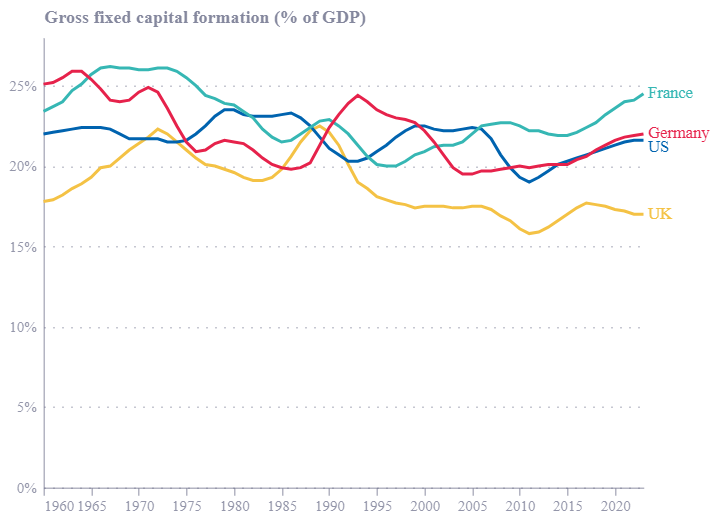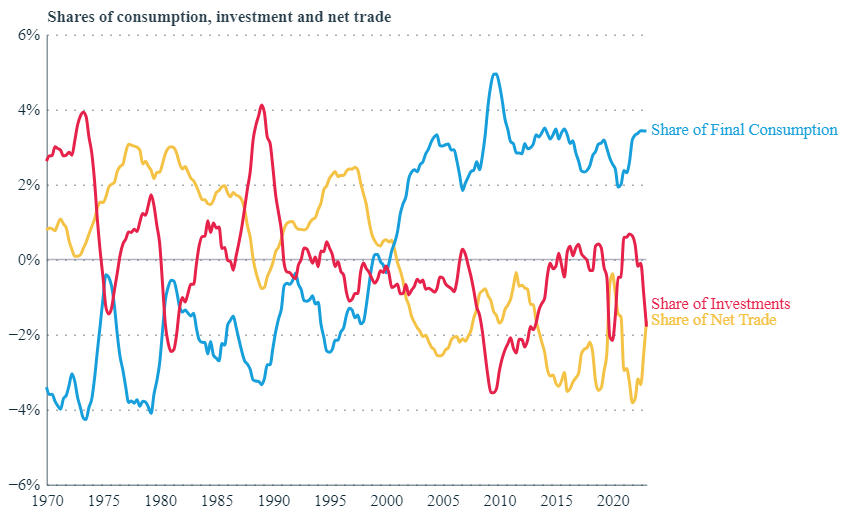Boosting productivity: why doesn’t the UK invest enough?
The UK economy has long suffered from chronic levels of underinvestment. Many factors explain the failure to invest enough. One recurring theme is short-term thinking – by managers who don’t invest in projects with long-term payoffs; and by governments that don’t provide a stable policy environment. This blog was written by Professor Jagjit Chadha from NIESR and Professor Tony Venables from Alliance Manchester Business School, based on insights from their work in The Productivity Agenda report.
Investment lies at the root of economic growth and prosperity. When an economy channels funds into capital, it creates the building blocks for a higher level of productivity in the future. Investment also fosters greater diffusion of the ideas and innovation that underpin technological progress and higher wages.
The UK economy has suffered from chronic levels of underinvestment compared with those economies that have delivered larger improvements in living standards over the past 25 years – such as France and Germany.
UK investment is low
The overall investment rate in the UK fell from a high of around 23% of GDP in the late 1980s, to around 17% from 2000 onwards – in other words, falling to just three-quarters of its previous share. Investment rates in typical G7 countries, on the other hand, remained largely in the range of 20-25%, as Figure 1 shows.
Figure 1: Investment as a share of GDP

Source: Chadha and Samiri, 2022
This decline was dominated by a fall in investment in equipment and machinery, including information and communications technology (ICT) equipment. This fell from around 8% of GDP in 1987-97 to less than 4% from 2009 onwards, the lowest share in the G7 (Alayande and Coyle, 2023). Much of this consists of business investment, the total of which dropped from around 12% of GDP to 9% in three decades.
A significant share of investment is now in hard-to-measure ‘intangibles’ – the stocks of knowledge, patents, brand value and goodwill – created or acquired by companies. A large component of this is intellectual property, investment in which is broadly constant at around 4% of GDP, so slightly increasing its share in investment as a whole.
The UK is also now well behind the share in France, Japan and the United States, having been above the average for G7 countries in the 1980s.
In the long run, the main drivers of productivity are technological progress and innovation, which are embodied in new investment and are fostered by investment in research and development (R&D).
Most of the new technologies employed in any one country, like the UK, have been developed in other countries. But an active domestic R&D programme is important, both to produce technologies required for UK firms to be internationally competitive, and to facilitate the absorption and adoption of technologies developed elsewhere.
Over the past 30 years, the share of R&D expenditure has been falling in the UK, to below 2% of GDP. Although R&D data are subject to revision, they suggest that UK spending is relatively low compared with other G7 countries. For example, Japan spends 3.5% of its income on R&D, while Germany and the United States spend approximately 2.8%.
Low investment is mirrored in other economic variables. The share of consumption in UK GDP has been rising steadily (by a full eight percentage points between 1970 and 2023). This is at the cost of investment falling by six percentage points of GDP and it is financed by net trade (and hence net foreign borrowing/lending) moving from a modest surplus to a deficit of around two percentage points of GDP (see Figure 2).
Figure 2: Consumption, net trade and investment shares of GDP: percentage point deviation from the mean, 1970 to 2023
 Source: Chadha and Samiri, 2022
Source: Chadha and Samiri, 2022
Public sector investment
UK public investment dropped from an average of 4.5% of GDP between 1949 and 1978 to 1.5% between 1979 and 2019. A considerable part of this decline can be explained by the privatisation programme of the Thatcher administration in the 1980s. The subsequent disappointing investment performance by utilities and the transport network raises questions about their regulation.
UK public investment in the economic activities that remain in the public sector has been low, and plagued by short-termism and stop-start implementation. Attempts to control public debt, especially since 2010 and with the establishment of the Office of Budget Responsibility (OBR), may have created incentives to trim public investment at successive fiscal events.
The remit of the OBR, which is focused on short-term output and debt projections, does not allow for such investment to feed through into the supply side of the economy and hence drive up income, which is the denominator of the debt-to-GDP equation (Chadha, 2023).
The UK’s experience compares unfavourably with other countries, as project management is subject to new political or financial hurdles that create uncertainty and delay. This ultimately affects both the cost-effectiveness of the investment, and the private sector’s willingness to invest in complementary assets.
Private sector investment
Private investment decisions depend on the balance between the costs of undertaking a project, the future benefits expected to accrue to the investor, and the objectives and decision processes of the investor.
Project costs
Is it more difficult or more expensive to undertake an investment project in the UK than a similar project in other countries?
Evidence here is fragmentary, covering many aspects of the obstacles to, and costs of, new investment projects. Land is expensive (in some places) and planning procedures often slower and more burdensome than elsewhere. Efficiency in the construction sector varies widely, and the lack of domestic capacity for undertaking major projects has reduced competitive pressures and raised construction prices.
Some evidence suggests that the combination of land and building regulations and construction costs creates significantly higher project costs in the UK than elsewhere.
Upgrading equipment – for example, ICT services – may also bring relatively high costs. Studies of the adoption of new digital technologies often point to the shortage of skilled workers able to install and operate the new tools as obstacles to investment.
Investment projects require finance, and there has been extensive research on the difficulties faced by firms in raising the necessary funds. The venture capital market in the UK is deeper than in other European countries, although it is regionally concentrated in the South East of England. It is also much thinner than that in the United States.
On the other hand, there are frequent and long-standing claims that firms, small and medium-sized enterprises in particular, are constrained by the difficulty of raising funds for long-term investment. Intangible investments, including R&D, are particularly hard to finance as they lack the collateral provided by tangible assets.
Expected returns
Investment projects yield returns by enabling firms to make the most of market opportunities, and by creating efficiencies that reduce subsequent operating costs.
Market opportunities arise if there is an expectation of growing domestic demand for the products or services that the business provides, or if the investment provides a base from which to supply export markets or participate in global value chains. This is particularly important for multinational firms engaged in foreign direct investment (FDI), which supply many markets and have a wide range of possible locations from which to operate.
These motives have been undermined by the events of the last 15 years. Austerity (cuts in public expenditure to reduce government budget deficits and debt), in both its post-global financial crisis and current forms, leads to expectations of low growth of domestic spending, and this in turn discourages investment.
Brexit has raised the cost of exporting and elevated levels of uncertainty. It has been particularly damaging to functioning within Europe-wide supply chains. Much of the UK’s past inward FDI has been described as an ‘export platform’. For example, Japanese firms have used the UK as a base from which to supply the European single market – a motivation the value of which is now much reduced.
While these two factors are likely to have depressed investment, the timing suggests that they are not a full explanation. What other underlying factors might be at play? There are many suspects, having a combined impact, rather than a single striking cause.
The competitive environment within which businesses operate matters. If firms face too little competition, their most profitable strategy might be to restrict output and raise prices, rather than lower costs or improve quality in order to grow their market share.
What about investments that are designed principally not to expand capacity but to reduce operating costs? There are two sides to this question. One is that some costs in the UK are already low, so the payoff to reducing them further is small. If low-skilled labour in the UK is cheap (and flexible), why bother to invest in equipment that might replace labour?
The other side is that some elements of costs in the UK are high and are outside firms’ control even if they do invest. This is particularly the case for complementary public investments. Poor transport infrastructure, high regulatory burdens, high energy costs, high housing and rental costs, and high costs of skilled workers make the UK a less attractive place for internationally mobile investment. They may also reduce the return on investments more broadly.
Uncertainty, short-termism and business behaviour
Uncertainty deters investment – it causes plans to be postponed, and the additional risk contributes to a high hurdle rate of return required to initiate a project. There has been a high degree of uncertainty around government policy – from fiscal matters (including corporate taxation) to strategy to particular sectors, and to regulation more broadly, as well as in the tenure of ministers.
Research on uncertainty in UK industrial policy points to a lack of coordination between different parts of government and other stakeholders, and an acute lack of consistency (Coyle and Muhtar, 2023). Industrial strategies and regulatory measures have been subject to frequent change, creating uncertainty and preventing the government from learning from experience over time.
Tax treatment is an aspect of this. Can capital expenditure be offset against future revenues? The UK regime has been through multiple changes. Although the current UK system is relatively generous, it has gone through at least 18 and perhaps as many as 24 changes since 1984. That complicates long-term planning for the private sector.
Finally, there is the issue of management quality and ambition. This varies hugely between firms, but there is evidence that the quality of UK management is low by international standards. In smaller firms, managers may be overwhelmed by the day-to-day running of the operation or preoccupied with ensuring the survival of the firm.
Both factors create short-termism. The strategic thinking about the long run that is needed for investment is absent. Where it does take place, it might be based on criteria that are biased towards short-term projects (for example, the payoff period criterion rather than the full value of a project over its lifetime).
Larger firms can have their own bias to short-termism, as the tenure of top managers is often short, and financial markets may create pressure to deliver short-run financial results designed to maximise share prices. In both the UK and the United States, the role of private equity is often viewed as a damaging aspect of ‘financialisation’, as debt is loaded onto companies to finance short-term payouts.
Investment should therefore be high in public spending priorities and policy design, not subject to capriciousness that we have seen repeatedly in the UK and so have come to expect to lift the UK out of the low investment trap. The country needs its leaders to find the political will to set long-term objectives and stick with them.
This blog was first published by Economics Observatory where a list of further reading and experts can also be found.



